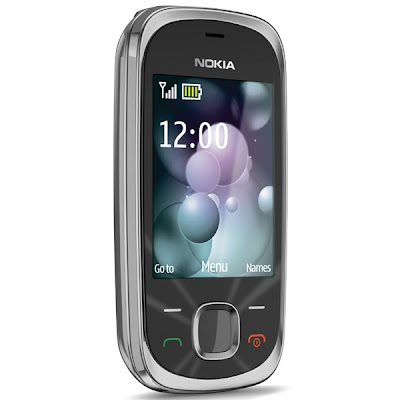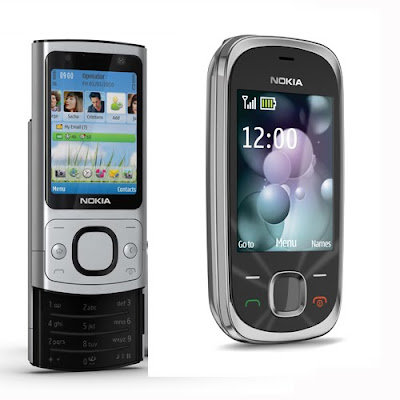HARGA|SPESIFIKASI NOKIA 7230


NOKIA 7230 REVIEW
Nokia 7230 is a compact slider with stunning looks. Rounded edges and a sleek finish make this Series 40 device easy on they eye at a price that’s even easier on the pocket. It doesn’t do badly on the feature front either whilst the 2.4-inch screen makes the most of the available space.
The Nokia 7230 is a connected little critter with Nokia Messaging on board, easy access to sharing snaps to Ovi, Flickr and Facebook and 3G for fast data transfer. Photos come courtesy of a 3.2-megapixel camera with dedicated camera button whilst a light alert will let you know when you get a new message or call.It is a neatly designed phone. The slider format helps keep things small, with a closed size of 98mm x 48mm x 14.75mm and an opened size of about 127mm tall. The slide mechanism is a little less solid than we’d like but it is definitely sprung and clunks well on opening and closing.
The screen is necessarily quite small at just 2.4-inches across diagonal corners. Its resolution of 240 x 320 pixels is relatively low too. But as you are unlikely to be doing much Web browsing with this handset due to its lack of 3G that is probably not going to be too much of a problem. Viewing angles aren’t great, but that is not a deal-breaker. In case you are thinking otherwise, we’ll confirm that the screen is not touch sensitive.
The numberpad keys click quite loudly when depressed and have a very firm action. Texting at speed should be no problem.
With the keyboard hidden away usage is confined to what you can get out of a very large D-pad, two softmenu buttons and the Call and End buttons as well as a single sidekey which activates the built in camera.
This shoots stills to a resolution of 3.2 megapixels, which is very much an entry level specification. You can choose to upload a photo to the Web direct from the camera.
If you’ve shot a still at the top resolution there is quite a wait while the handset prepares it for over the air transmission, and when that’s done your only choice is to share it via Ovi.
You can get photos onto other sites, such as Flickr, but you need to fiddle around and find the app, log in to the site, then upload. The same goes for using Facebook, MySpace, and YouTube.
Apps for these services along with Opera Mini for Web browsing, the Ovi Store and a few other bits like a clothing size converter are hidden away in a Collections folder, itself in an Extras folder, which is in the Applications folder you see on the main menu. It is a bit of a Russian dolls approach to organising apps.
The features set is necessarily humble. There is no Wi-Fi, no GPS and network connectivity is limited to GPRS and EDGE for data. Of course Bluetooth is here.
Out of the box our review handset had 14MB of internal memory free, but it comes with a 2GB microSD card providing quite a boost. Sadly the card slot is under the battery cover, so you have to power the handset down to do card swapping.
Music playback is catered for of course, and Nokia has not only built a 3.5mm headset jack into the casing so you can ditch the provided earphones in favour of your own favourites but also put this on the top edge, so that a connected headset does not snag the pocket. Makers of more expensive and fancy handsets please take note.
Nokia 7230 is a compact slider with stunning looks. Rounded edges and a sleek finish make this Series 40 device easy on they eye at a price that’s even easier on the pocket. It doesn’t do badly on the feature front either whilst the 2.4-inch screen makes the most of the available space.
The Nokia 7230 is a connected little critter with Nokia Messaging on board, easy access to sharing snaps to Ovi, Flickr and Facebook and 3G for fast data transfer. Photos come courtesy of a 3.2-megapixel camera with dedicated camera button whilst a light alert will let you know when you get a new message or call.It is a neatly designed phone. The slider format helps keep things small, with a closed size of 98mm x 48mm x 14.75mm and an opened size of about 127mm tall. The slide mechanism is a little less solid than we’d like but it is definitely sprung and clunks well on opening and closing.
The screen is necessarily quite small at just 2.4-inches across diagonal corners. Its resolution of 240 x 320 pixels is relatively low too. But as you are unlikely to be doing much Web browsing with this handset due to its lack of 3G that is probably not going to be too much of a problem. Viewing angles aren’t great, but that is not a deal-breaker. In case you are thinking otherwise, we’ll confirm that the screen is not touch sensitive.
The numberpad keys click quite loudly when depressed and have a very firm action. Texting at speed should be no problem.
With the keyboard hidden away usage is confined to what you can get out of a very large D-pad, two softmenu buttons and the Call and End buttons as well as a single sidekey which activates the built in camera.
This shoots stills to a resolution of 3.2 megapixels, which is very much an entry level specification. You can choose to upload a photo to the Web direct from the camera.
If you’ve shot a still at the top resolution there is quite a wait while the handset prepares it for over the air transmission, and when that’s done your only choice is to share it via Ovi.
You can get photos onto other sites, such as Flickr, but you need to fiddle around and find the app, log in to the site, then upload. The same goes for using Facebook, MySpace, and YouTube.
Apps for these services along with Opera Mini for Web browsing, the Ovi Store and a few other bits like a clothing size converter are hidden away in a Collections folder, itself in an Extras folder, which is in the Applications folder you see on the main menu. It is a bit of a Russian dolls approach to organising apps.
The features set is necessarily humble. There is no Wi-Fi, no GPS and network connectivity is limited to GPRS and EDGE for data. Of course Bluetooth is here.
Out of the box our review handset had 14MB of internal memory free, but it comes with a 2GB microSD card providing quite a boost. Sadly the card slot is under the battery cover, so you have to power the handset down to do card swapping.
Music playback is catered for of course, and Nokia has not only built a 3.5mm headset jack into the casing so you can ditch the provided earphones in favour of your own favourites but also put this on the top edge, so that a connected headset does not snag the pocket. Makers of more expensive and fancy handsets please take note.
PRICE : 240USD (HARGA)
SPECIFICATIONS
General
2G Network GSM 850 / 900 / 1800 / 1900
3G Network UMTS 900 / 2100 / 1900
UMTS 850 / 1900 / 2100 - American version
Announced 2009, November
Status Available. Released 2010, February
Size
Dimensions 98 x 48 x 14.8 mm, 64 cc
Weight 100 g
Display
Type TFT, 256K colors
Size 240 x 320 pixels, 2.4 inches
Sound
Alert types Vibration; MP3 ringtones
Speakerphone Yes
- 3.5 mm audio jack
Memory
Phonebook 2000 entries, Photocall
Call records 20 dialed, 20 received, 20 missed calls
Internal 45 MB
Card slot microSD, up to 16GB, 2GB card included, buy memory
Data GPRS Class 32, 100 kbps
EDGE Class 32, 296 kbits
3G Yes, 384 kbps
WLAN No
Bluetooth Yes, v2.1 with A2DP
Infrared port No
USB Yes, v2.0 microUSB
Camera
Primary 3.15 MP, 2048x1536 pixels
Video Yes, QCIF@8fps
Secondary No
Features
Messaging SMS, MMS, Email, IM
Browser WAP 2.0/xHTML, HTML
Radio Stereo FM radio with RDS
Games Snake III, Bounce II, Sudoku II, Rally Start + downloadable
Colors Graphite, Hot Pink
GPS No
Java Yes, MIDP 2.1
- MP3/eAAC+/WAV/WMA player
- MP4/H.263/H.264/WMV player
- Flickr/Ovi Upload
- Nokia Maps
- Nokia Life Tools
- Widsets
- Flash Lite 3.0
- Voice command/dial/memo
- T9


0 comments:
Post a Comment